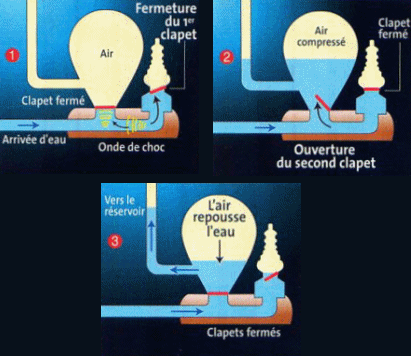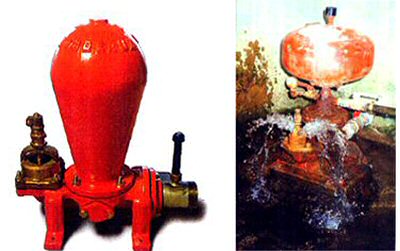The hydraulic ram hit again
Article published in Sciences et Avenir in November 2003. By David Larousserie. A few enthusiasts have brought out of oblivion this ingenious machine born with the Republic in 1792. It could even have a bright future, because it works non-stop without energy.
The hydraulic ram is not dead. This water pump system, invented more than two hundred years ago, is even going back into service, thanks to a French company and a small group of high school students. It was time ! Few people in fact know this rustic, economical, ecological and yet effective technology, unless you are a plumber and install water hammer systems to protect the pipes. Or to have heard, in his youth, the characteristic poum-poum of this machine, at the edge of a stream or a spring.

The ram principle is based on the overpressure created when the flow of a liquid is suddenly interrupted, for example, when a tap is quickly closed. The resulting shock wave is often violent and damages unprotected pipelines. The industrialist and inventor Joseph de Montgolfier had the idea, in 1792, to divert this effect wisely. After having flown aerostats with his brother Etienne, he filed the patent for this autonomous and efficient pump and called it a ram, because of the noise and the violence of the blow. A large cast iron bell firmly fixed to a base to resist the pressure, two bronze valves, two water inlets and you're done. Installed near a source or a waterfall, the machine can lift the liquid up to several tens of meters without energy other than that provided by the current (see diagram). Once launched, it does not stop. Or almost. Only the drop in the inflow, frost or an impurity in the water that would block the valves puts an end to its regular thrusts.

The ram is also indestructible. At the Château de la Ménardière (Deux-Sèvres), for example, an example of over 120 years still works, having just undergone a light restoration. The invention of the Montgolfier brothers spread slowly and experienced its golden age between 1870 and 1900. The rams of the Bollée, Pilter, or Mangin brand were then used to water parks, gardens and vegetable gardens. The 200 hectares of gardens in the city of Richelieu (Indre-et-Loire) are, for example, still supplied by a ram which carries water over more than 600 meters. In 1876, the archives of the main manufacturer, Bollée, listed a hundred around the department of Indre-et-Loire. After the Second World War, the electrification and water supply plans put a stop to this machine, however indestructible.
In 1950, France had a dozen manufacturers. There is only one left today, SARL Walton, in Bordeaux, specializing in watering and pumping. “In 1998, refusing to stop what my grandfather had started in 1910, I created a website to talk about the hydraulic ram, of which we only sold one or two pieces a year. At first, I only installed a reproduction of one of our models from 1936, ”recalls Richard Walton, its director. Despite the poverty of the site, it is success. The company now sells around 50 rams a year and has 250 users on file. There are object lovers who opt for the smallest model. Farmers, from Limousin or Cantal, who choose more efficient models, some of which are sufficient to supply water to a herd of 100 heads, or approximately a flow rate of 10 liters per day. Other customers are in Africa, where Walton rams feed villages of 000 to 600 people in need of up to 1000 liters per day. "For these countries, the advantage is also that at the fountain, the water flows constantly, which avoids the stagnation of the liquid and the risk of contamination", adds Richard Walton, who also has customers in Vietnam. The absence of external power and easy maintenance are particularly suited to developing countries.

Two pictures of hydraulic rams. On the left, a recent model of the French company Walton, the only one yet to market rams. At right a model still in operation after 50 years.
All things considered, it is a ram that saved a French village in the 50th century. "If there had not been this system, our ancestors would not have been able to exploit the nursery which attracted jobs and wealth", recalls Gilbert Barbier, deputy mayor of Saint-Appolinaire (Rhône), to 15 kilometers from Lyon. A century later, Gilbert Barbier wanted to revive the ram of his town that many had forgotten, and which nobody knew how. Taking advantage of an open day at the Jules-Verne vocational school in Tarare, XNUMX kilometers away, Gilbert Barbier asked the principal for help. His students were then looking for a project to participate in the Physics Olympics, a friendly competition between different French high schools, based on experimentation. Laurent Buccini, Loïc Jacquemot, Adrien Rabany, Guillaume Rousset and Grégory Saint-Paul, with their teachers Mustapha Errami and Benjamin Topouzkhanian, get to work. They build their own ram, and it works!
The water even rises to the sixth floor of their high school. At the competition, in February, in Paris, the jury, impressed by this system which "watered" the attic of the Palais de la Découverte, awarded them the Prize of the French Nuclear Energy Society ...
New consecration, June 14, with the presentation in the village of Saint-Appolinaire. The hundred inhabitants were present to see the water rising to the steeple of the church, 17 meters above the ground, violently twisting the plastic pipes with each water hammer. "I am happy to have saved this object and given the honor to vocational training", testifies Gilbert Barbier.
The high school students have since obtained their vocational baccalaureate with honors, and the communal ram no longer supplies the nursery, but a reserve of 50 cubic meters of water for the firefighters.
The high school students then went to the Moscow Exposcience in July with their machine. Professors chatted with them for hours, in Russian and English. A German even wanted to buy them the prototype!
“We preferred to explain to him how to make it himself,” says Grégory Saint-Paul. It's not hard. It's just fun. "At each presentation, it was the feast of science", adds Mustapha Errami, one of his teachers.
The hydraulic ram is still somewhat resistant to science. Strangely enough, its exact return has still not been calculated. “The ram is impossible to equate. This machine does not like engineers. It is a peasant machine made by a peasant for other peasants, ”sums up, somewhat provocatively, Richard Walton. The ram is not dead, it is still pumping.

